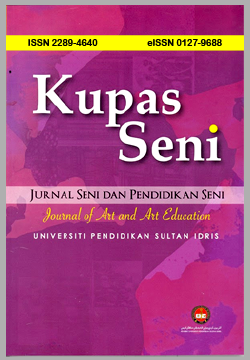The Design and Development of The ‘Grid and Game’ Module Using the Addie Model for Remedial Pupils
DOI:
https://doi.org/10.37134/kupasseni.vol11.2.3.2023Keywords:
Mathematics, ADDIE model, Multiplication, Remedial, ModuleAbstract
Mathematics is a compulsory subject in primary and secondary school curricula in Malaysia. Even though it is important and needed in daily life, there are many pupils who are afraid of this subject, especially during tests and examinations. This happened among the mathematics remedial pupils, as they have not mastered the basic arithmetic skills as required. Thus, this study explores the design and development process of the ‘Grid and Game’ module. This module plays a vital part in delivering the understanding and knowledge of multiplication skills for remedial pupils. Thus, the ‘Grid and Game’ module should be designed attentively and systematically. The aim of this paper is to provide specific information about the instructional design and development of the ‘Grid and Game’ module by applying the ADDIE model. One of the instructional design methods that many researchers widely use is the ADDIE model because it is relevant to the standard of learning and designing which provides good procedure input in designing the instructional module. The five phases in the ADDIE model are analysis, design, development, implementation, and evaluation. The result of the evaluation shows this module can enhance remedial pupils’ understanding of mastering multiplication skills.
Downloads
References
Abd Razak, A. Z., Surat, S., & Abd Majid, R. (2020). The Design of GIFTED Motivation Module Using the ADDIE Model Approaches Among the Gifted and Talented Students. International Journal of Academic Research in Progressive Education and Development, 9(2), 509–517. https://doi.org/10.6007/ijarped/v9-i2/7494
Ahmad, N. A., & May, Y. S. (2018). Challenges in Preparing Teachers for Inclusive Education and Its Impact to Students with Learning Disabilities. International Journal of Academic Research in Progressive Education and Development, 7(3). https://doi.org/10.6007/ijarped/v7-i3/4575
Aldoobie, N. (2015). ADDIE Model. American International Journal of Contemporary Research, 5(6), 69–73.
Curry, J. H., Johnson, S., & Peacock, R. (2020). Robert Gagné and the systematic design of instruction. Design for Learning: Principles, Processes, and Praxis, 1–12. https://edtechbooks.org/id/robert_gagn_and_systematic_design#chapterTitle
Embong, Z., Syamimi, N., Adnan, M., Saidin, N., & Ibrahim, H. (2019). Effects of Visual Approach in Teaching Mathematics for Malaysian Secondary School: A Case Study. Journal of Human Development and Communication, 8(2013), 97–106.
Lee, H. Y., Mohd Nor, N., & Wong, Y. S. (2022). Analisis Keperluan Pengajaran Dan Pembelajaran Pendidikan Seni Visual Berasaskan Kolaboratif-Konstruktivis Di Sekolah Rendah. Kupas Seni, 10, 90–103. http://ojs.upsi.edu.my/index.php/JSPS/article/view/6591/3453
Mariappan, P., Khairani, M. Z., & Chanthiran, M. (2022). Design and Development Research (DDR) Approaches in the Development of Koin-Art Cooperative Learning Model for Student of Inclusive Education Program. Kupas Seni, 10, 66–77.
Mohd Asnorhisham, A., & Abdul Rahim, H. (2017). Pendekatan pengajaran secara berkumpulan dalam program pemulihan khas Bahasa Melayu. Malay Language Education Journal –MyLEJ, 66(1), 2180–4842.
Muslimin, M. S. M. N., & Mansor, A. Z. (2017). Using the ADDIE Model to Design and Develop a Mobile Learning Application for Microeconomics Module. PROCEEDINGS OF THE INTERNATIONAL POSTGRADUATE CONFERENCE ON RESEARCH IN EDUCATION (IPCoRE.
Nur Farhana Mohd Jais, Ishak, S. A., & Melor Md Yunus To. (2022). Developing the Self- Learning Interactive Module using ADDIE Model for Year 5 Primary School Students. International Journal of Academic Research in Progressive Education and Development, 11(1), 615–630. https://doi.org/10.6007/ijarped/v11-i1/11919
PISA 2018 Results (Volume I). (2019). OECD. https://doi.org/10.1787/5f07c754-en RM, G., WW, W., KC, G., JM, K., & JD, R. (2005). Principles of instructional design.
Sahaat, Z., Nasri, N. M., & Abu Bakar, A. Y. (2020). ADDIE Model In Teaching Module Design Process Using Modular Method: Applied Topics in Design And Technology Subjects. 464(Psshers 2019). https://doi.org/10.2991/assehr.k.200824.161
Schoonenboom, J., & Johnson, R. B. (2017). How to Construct a Mixed Methods Research Design. Kolner Zeitschrift Fur Soziologie Und Sozialpsychologie, 69, 107–131. https://doi.org/10.1007/s11577-017-0454-1
Stapa, M. A., & Mohammad, N. (2019). The Use of Addie Model for Designing Blended Learning Application at Vocational Colleges in Malaysia. Asia-Pacific Journal of Information Technology & Multimedia, 08(01), 49–62. https://doi.org/10.17576/apjitm- 2019-0801-05
Tagie, G., Merman, H., Taharuddin, N. S., & Ibrahim, N. A. (2022). Gamification in Art and Design Appreciation. Kupas Seni, 10(2), 93–103.
Yoong, S. (2022). Applying the ADDIE Model to Design and Develop an Instrument for Dyscalculia. Seameo, 1(January), 55–68. https://www.researchgate.net/profile/Yoong- May/publication/366861346_Applying_the_ADDIE_Model_to_Design_and_Develop_an_I nstrument_for_Dyscalculia/links/63b57caba03100368a51dcdf/Applying-the-ADDIE- Model-to-Design-and-Develop-an-Instrument-for-Dyscalculia.p
Downloads
Published
How to Cite
Issue
Section
License
Copyright (c) 2023 Vanesri Kasi, Rozniza Zaharudin

This work is licensed under a Creative Commons Attribution-NonCommercial-ShareAlike 4.0 International License.





